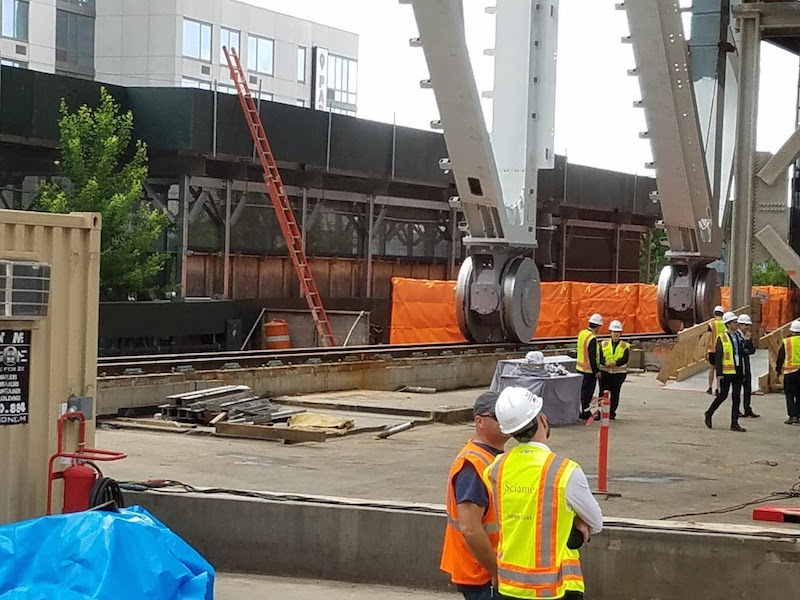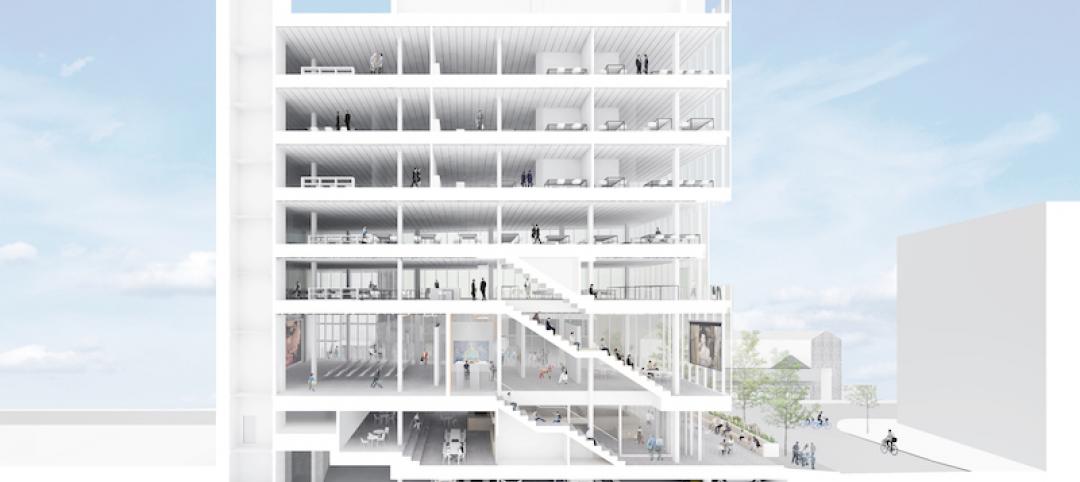On May 24, The Shed, a non-profit cultural organization that’s backed by some of the heaviest hitters in New York City, announced the completion of erecting the structural steelworks for the telescoping outer shell of a 200,000-sf artistic center, also called The Shed, under construction in Lower Manhattan’s west side.
This announcement came one day after former New York Mayor Michael Bloomberg said that he would be donating a total of $75 million to this project through his Bloomberg Philanthropies.
That brings to $421 million that amount that has been raised so far from this project’s $500 million capital campaign, according to the New York Times. The Shed’s benefactors include media mogul Barry Diller, and Stephen Ross, chairman of the builder/developer Related Companies.
While in office, the Bloomberg administration rezoned the area running roughly from 30th Street to 41st Street, and between 8th and 11th avenues for its ambitious redevelopment plan that included Hudson Yards and The Shed. Bloomberg personally spearheaded the idea of placing a cultural center in the midst of this office-heavy redevelopment. Construction of The Shed began in 2015 and should be completed next year.
When it opens in the Spring of 2019, The Shed will run along the popular High Line elevated walkway and garden. The organization is leasing the land, and will lease the building, from the city.
“This will be a platform for art, for artists to create on,” says Daniel Doctoroff, a former deputy mayor who is chairman of the board of The Shed. He said Bloomberg’s mandate for this project was that it be “unique” and put the lower west side “on the cultural edge.”

David Rockwell of The Rockwell Group (left) and Liz Diller of Diller Scofidio + Renfro talk about how The Shed was designed to be as flexible as possible to accommodate the uncertain artistic world of the future. Image: BD+C
Elizabeth Diller, a partner with Diller Scofidio + Renfro, which with The Rockwell Group designed the center, says this project forced the Building Team to think about what the arts would be like in 10 to 15 years. Their conclusion was that this is unknowable, so the building needed to be designed with the utmost flexibility.
A manifestation of that flexibility is a gigantic movable shell, open on three sides, which can be deployed over a 20,000-sf open plaza to create a 17,500-sf hall whose lighting, sound, and temperature can be controlled. The 8-million-pound shell is mounted on 6-ft-diameter wheels that roll along slide rails. The structure, operated by 90-horsepower motors, can be opened or closed within seven minutes.

The Shed's movable shell sits on steel wheels, 6 ft in diameter, that roll on slide rails. Image: BD+C
The movable shell rises 135 feet above the plaza, and can support up to 4,000 tons of building systems and production equipment. Its exposed steel will be clad in translucent pillows of ETFE, a Teflon-based polymer, some of whose panels will measure 70 ft in length.
The plaza would have a theater seating capacity of 1,250 and a standing capacity of 3,000. (By comparison, New York’s Radio City Music Hall seats just over 6,000 people; and the city’s Beacon Theater seats roughly 2,900.)
The shell retracts into a base building with eight floors, each designed for multiple uses. The top floor will house a 3,300-sf rehearsal space, a 9,500-sf flexible events space, and a 1,700-sf labs dedicated to early-career local artists.
Below that is an 11,700-sf, 500-seat black-box theater that can be subdivided into three smaller performance spaces. The building will also include two levels of galleries with a combined 25,000 sf of exhibit space and 19-ft-high ceilings.
Back-of-house space for offices and mechanicals, dressing rooms, and storage is on the first floor.
In charge of programming The Shed is Alex Poots, the organization’s Artistic Director and CEO. Previously, Poots was founding Director of the Manchester International Festival, and Artistic Director of New York’s Park Avenue Armory. He said The Shed would “welcome artists and audiences from all walks of life.” The Shed has already launched a free, citywide residency program in dance activism for young people, Flex NYC, in cooperation with Reggie Gray of D.R.E.A.M. Ring dancers.
The organization also just hired Kevin Slavin as its Chief Technology Officer. Slavin comes from MIT's Media Lab.
Other Building Team members include Thornton Tomasetti (SE), Sciame Construction (CM), Hardesty & Hanover (kinetic engineering services), Jaros Baum & Bolles (MEP, FP), Levien + Co. (owner’s rep), Cimolai (structural steel), Cimolai Technology (kinetic services), and Stonebridge (steel erection).
Related Stories
Giants 400 | Aug 30, 2021
2021 Giants 400 Report: Ranking the largest architecture, engineering, and construction firms in the U.S.
The 2021 Giants 400 Report includes more than 130 rankings across 25 building sectors and specialty categories.
Resiliency | Aug 19, 2021
White paper outlines cost-effective flood protection approaches for building owners
A new white paper from Walter P Moore offers an in-depth review of the flood protection process and proven approaches.
Cultural Facilities | Aug 2, 2021
A new venue for the San Diego Symphony’s outdoor performances opens this week
Rady Shell at Jacobs Park was funded almost entirely by private donors.
Cultural Facilities | Jun 28, 2021
Maine’s Children’s Museum & Theatre moves into new location that doubles its size
Interactive exhibits are among its features.
Resiliency | Jun 24, 2021
Oceanographer John Englander talks resiliency and buildings [new on HorizonTV]
New on HorizonTV, oceanographer John Englander discusses his latest book, which warns that, regardless of resilience efforts, sea levels will rise by meters in the coming decades. Adaptation, he says, is the key to future building design and construction.
Multifamily Housing | Jun 3, 2021
Student Housing Trends 2021-2022
In this exclusive video interview for HorizonTV, Fred Pierce, CEO of Pierce Education Properties, developer and manager of off-campus student residences, chats with Rob Cassidy, Editor, MULTIFAMILY Design + Construction about student housing during the pandemic and what to expect for on-campus and off-campus housing in Fall 2021 and into 2022.
Digital Twin | May 24, 2021
Digital twin’s value propositions for the built environment, explained
Ernst & Young’s white paper makes its cases for the technology’s myriad benefits.
Wood | May 14, 2021
What's next for mass timber design?
An architect who has worked on some of the nation's largest and most significant mass timber construction projects shares his thoughts on the latest design trends and innovations in mass timber.
Cultural Facilities | Apr 1, 2021
A Connecticut firm deploys design to assist underserved people and communities
Hartford, Conn.-based JCJ Architecture traces its roots to 1936, when the U.S. was just coming out of an economic depression and its unemployment rate was still 14%. In 2021, with the country trying to recover economically from the impact of the coronavirus, and with questions about social inequity entering the public debate as rarely before, JCJ has focused its design work on projects and clients that are committed to social responsibility and advocacy, particularly for underserved or marginalized communities.
Cultural Facilities | Mar 1, 2021
Moise Safra Center completes in New York City
The project will act as a second home for the Jewish community it serves.







![Oceanographer John Englander talks resiliency and buildings [new on HorizonTV] Oceanographer John Englander talks resiliency and buildings [new on HorizonTV]](/sites/default/files/styles/list_big/public/Oceanographer%20John%20Englander%20Talks%20Resiliency%20and%20Buildings%20YT%20new_0.jpg?itok=enJ1TWJ8)









